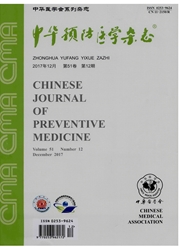

 中文摘要:
中文摘要:
目的研究和探讨环境内分泌干扰物(EED)与儿童性早熟发病的关系。方法收集2004年5月至2005年9月在性早熟专科门诊就诊的初诊患儿79例及正常儿童42名。运用反相高效液相色谱分析法测定性早熟患儿及正常儿童血清中4-壬苯酚(4-NP)、二氯二苯二氯乙烯(P,P’-DDE)和邻苯二甲酸-2-乙基己酯(DEHP)的含量。同时测定患儿子宫和卵巢体积、骨密度及血清雌二醇(E2)含最。将血清EED含量与靶器官的临床指标做相关性分析及多元线性回归分析。结果证常儿童血清中均检测到一定含量的P,p'-DDE(14.93~40.39ng/ml),部分正常儿童血清中检测到一定含量的4-NP及DEHP(末检出-6.77ng/ml,未检出-17.61ng/ml)。性早熟患儿血清中-4-NP(未检出-16.68ng/ml)、P,P'-DDE(40.03—91.68ng/ml)及DEHP(未检出-64.71ng/ml)含量高于正常儿童。性早熟患儿血清中4-NP与子宫体积、卵巢体积和骨密度均呈显著正相关;P,P'-DDE与子宫体积呈显著正相关。4-NP对子宫体积的影响强度是P,P'-DDE的1.3倍。结论儿童较为普遍地受到环境内分泌于扰物的污染,环境内分泌干扰物的污染与儿童性早熟的发病有密切关系,是其重要致病因素之一;不同种类的环境内分泌干扰物对靶器官的致病作用强度有所不同。
 英文摘要:
英文摘要:
Objective To investigate the role of environmental endocrine disruptors (EEDs) in causing the precocious puberty, Methods The blood samples were collected from 79 cases of precocious puberty patients and 42 cases of normal children. The concentrations of 4-nonylphenol (4-NP), 1,1-dichloro- 2,2, bis (p-chlorophenyl) ethylene ( p, p'-DDE) and di-2-ethylhexyl phthalate (DEHP) in blood serum samples were measured by using reversed-phase high performance liquid chromatography (HPLC). The volume of uterus and ovary, the bone density, and the content of estradiol (E2 ) in serum were determined at the same time. The contents of EEDs in blood serums of precocious puberty and the indices of the target organs were analyzed by using of correlation and regression. Results In normal control group, p,p'-DDE was detected in all the blood samples( 14, 93 -40. 39 ng/ml), but 4-NP and DEHP were detected in some samples (ND -6. 77 ng/ml,ND - 17.61 ng/ml). The levels of 4-NP,p,p'-DDE and DEHP in blood serum in precocious puberty group were notably increased than that in control group (P 〈 0. 01 ). In precocious puberty group, there was a positive correlations between the 4-NP in volume of uterus and the volume of ovary and the density of bone(r =0. 394, 0. 286,0. 237, P 〈 0. 01) ; p,p'-DDE and volume of uterus also showed a the positive correlation (r =0. 306,P 〈 0.01). The influencing extent of 4-NP was 1.3 times to that of the p,p'-DDE, Conclusion The normal children and the children with precocious puberty should be all contaminated by EEDs, and the later be exposured to more EEDs. There might exist a close relationship between EEDs and the precocious puberty, and EEDs should be an important factor in causing the disease. Different kinds of EEDs might have different influencing extents to the target organs.
 同期刊论文项目
同期刊论文项目
 同项目期刊论文
同项目期刊论文
 期刊信息
期刊信息
